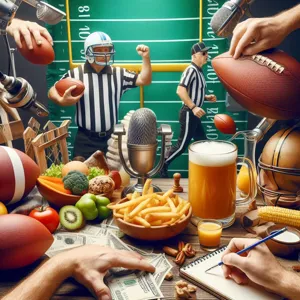American football is a sport rich in strategy, teamwork, and intensity, but it’s also governed by a complex set of rules that can leave both fans and players scratching their heads.
At the heart of this intricate system is the whistle, a powerful sound that can shift the momentum of a game in an instant. Understanding the various penalties, from offside to personal fouls, is crucial for grasping how they affect gameplay and team dynamics. In this blog post, we’ll delve into the most common penalties in American football, exploring their implications on the field, how they can change the course of a match, and what they mean for players, coaches, and spectators alike. Whether you’re a seasoned fan or new to the game, join us as we break down the significance of the whistle and the penalties that shape America’s favorite pastime.
1. Introduction to the Whistle: The Role of Officials

In American football, the whistle is more than just a sound; it is a pivotal instrument that governs the flow of the game and ensures fair play. At the heart of this system are the officials—trained professionals who wield the power to enforce the rules of the game. Their authority is not only essential for maintaining order on the field but also serves to protect the integrity of the sport.
Each official, whether they are on the field or in the booth, plays a specific role, from the referee, who oversees the entire game, to the line judge, who focuses on the action along the line of scrimmage. These individuals are tasked with making split-second decisions, interpreting the rules, and often facing the loud scrutiny of players, coaches, and fans alike. When a penalty is called, the sound of the whistle pierces the air, signaling a halt to the action—a moment that can dramatically shift the momentum of the game.
Understanding the penalties that arise in football is crucial for grasping how they can affect game dynamics. A defensive holding call can prolong a drive, while an unsportsmanlike conduct penalty can shift the tide of a match. Moreover, the strategic implications of these calls can resonate beyond just the current play, influencing coaches’ decisions and player behaviors throughout the game. As we delve deeper into the various types of penalties, we’ll uncover not only the rules themselves but also the profound impact they have on the outcome of the game and the emotions of all involved. The whistle, therefore, is not merely a signal; it is a powerful tool that shapes the very essence of American football.
2. Overview of Common Penalties in American Football
American football is a dynamic and fast-paced game, where split-second decisions can make or break a play. However, along with the excitement comes a complex web of rules and regulations, leading to a variety of penalties that can drastically alter the flow of the game. Understanding these common penalties is crucial for fans and players alike, as they can not only affect the outcome of a match but also shape strategies on the field.
One of the most frequently called penalties is **offside**, which occurs when a player crosses the line of scrimmage before the ball is snapped. This five-yard penalty can thwart an offensive drive before it even starts, forcing teams to rethink their approach. Similarly, the **false start** penalty, where an offensive player moves illegally before the snap, can disrupt the rhythm of the game and add strain to a team’s momentum.
Another notable penalty is **holding**, which can be called on either offensive or defensive players. Offensive holding results in a ten-yard loss, while defensive holding incurs a five-yard penalty and can result in an automatic first down for the offense. The implications of holding can significantly hinder a team’s progress, especially during crucial moments in the game.
Additionally, **pass interference** is a pivotal penalty that can swing the tide of a game. When a defensive player makes illegal contact with an offensive player attempting to catch a pass, it results in a penalty that varies in yardage depending on the severity of the infraction. This can lead to significant gains for the offense, potentially setting up a scoring opportunity.
Moreover, **unsportsmanlike conduct** and **personal foul** penalties emphasize player behavior on the field. These penalties, which can result in 15-yard losses or gains, serve not only to maintain the integrity of the game but also to manage player safety.
The cumulative effect of these penalties can be profound. A series of infractions can stall an offense, lead to loss of scoring opportunities, and shift the momentum to the opposing team. Coaches often spend hours reviewing film to understand how penalties are affecting their strategies and to teach players the importance of discipline and awareness on the field. As fans, recognizing these common penalties helps us appreciate the intricacies of the game and the skill required to navigate its challenges.
3. Offside: Understanding the Basics and Consequences

Offside is one of the most commonly misunderstood penalties in American football, yet its implications can significantly alter the flow of a game. At its core, the offside penalty occurs when an offensive player crosses the line of scrimmage before the ball is snapped. The moment the ball is put into play, all players must be on their respective sides of the line, ensuring fair play and an equal chance for both teams to execute their strategies.
When a player is called offside, the consequences are immediate and impactful. The offending team incurs a five-yard penalty, which not only shifts the line of scrimmage back but often alters the tactical approach for the next play. For instance, if an offense was facing a manageable third down, an offside call can transform it into a more challenging situation, potentially forcing them to reconsider their play calling. In some cases, this can even disrupt the rhythm of the entire offensive unit, which may lead to further mistakes down the line.
Moreover, the psychological impact of an offside call can be profound. Players may become overly cautious, second-guessing their movements and timing, which can lead to a cascade of penalties. For the defending team, however, a successful offside call can serve as a morale booster, reinforcing their focus and discipline on the field. Ultimately, while the penalty may seem minor in the grand scheme of the game, its ability to shift momentum and affect player performance makes understanding the basics of offside crucial for fans and players alike.
4. Holding: Types, Enforcement, and Impact on Play
Holding is one of the most frequently called penalties in American football, and its implications can significantly influence the flow and outcome of a game. At its core, holding occurs when a player uses their hands or arms to illegally impede an opponent, preventing them from being able to move freely. This infraction can take many forms, categorized mainly into two types: offensive holding and defensive holding.
**Offensive Holding** typically happens when a player on the offense grabs or holds a defender, usually to protect the quarterback or create space for a running back. This penalty is enforced from the spot of the foul and results in a loss of ten yards, which can be particularly detrimental during critical moments of a drive. Imagine a quarterback scrambling to avoid a sack, only to have a flag thrown for holding—what was once a promising play is now a setback, forcing the offense to overcome a longer yardage situation.
On the other hand, **Defensive Holding** is called when a defensive player illegally holds an offensive player, usually a receiver, before the ball is thrown. This penalty is less severe, resulting in a five-yard gain for the offense and an automatic first down. While it may seem minor compared to its offensive counterpart, defensive holding can disrupt defensive strategies and give the offense a fresh set of downs, potentially shifting momentum in favor of the attacking team.
The enforcement of holding penalties can have rippling effects on both teams. A ten-yard setback can stall an offensive drive, while a five-yard gain can rejuvenate a struggling offense. Coaches often devise game plans around these potential penalties, knowing that a crucial holding call could change the trajectory of the game. Moreover, the psychological impact on players cannot be underestimated; a team that faces repeated holding penalties may start to feel the pressure, leading to further mistakes as frustration mounts.
In essence, holding is more than just a penalty; it is a pivotal element that can alter the dynamics of a game. Understanding its nuances helps fans appreciate the complexities of football, where every play can hinge on a single infraction, influencing not just the score, but also the very momentum of the match.
5. Pass Interference: Definitions and Controversies

Pass interference is one of the most contentious penalties in American football, often sparking heated debates among players, coaches, and fans alike. Defined as illegal physical contact by a defensive player against an offensive player when the ball is in the air, pass interference can drastically alter the momentum of a game. When a defender impedes the receiver’s ability to catch the ball, whether through holding, pushing, or any form of obstruction, officials are quick to throw the flag, resulting in a penalty that typically grants the offense a significant advance in yardage—usually 15 yards or an automatic first down, depending on the nature of the infraction.
The controversy surrounding pass interference lies not only in its subjective nature but also in the varying interpretations of what constitutes “interference.” A defensive back may argue that they were making a legitimate play on the ball, while the offensive team insists that they were unfairly obstructed. This gray area often leads to frustration among fans, especially when a pivotal call—or lack thereof—can affect the outcome of a game. The introduction of replay review for pass interference calls was intended to mitigate this issue, but it has brought its own set of complexities, as coaches must weigh the risk of challenging a call against the potential for further controversy.
The impact of a pass interference penalty can be seismic. A well-timed call can shift the momentum in favor of the offense, providing them with a fresh set of downs in critical situations or allowing them to capitalize on defensive mistakes. Conversely, a missed call can leave an offense stifled, forcing them into tighter situations or missed opportunities. For teams, understanding the nuances of pass interference and training their players in proper techniques can make all the difference in their defensive strategy. Ultimately, while pass interference is an integral part of the game, its inherent controversies keep fans on the edge of their seats, making every catch—and every call—worth watching.
6. Personal Fouls: Tackling the Definition and Effects
In the world of American football, personal fouls represent some of the most serious infractions on the field, often resulting in significant penalties that can influence the outcome of a game. Defined as unnecessary or excessive contact that violates the spirit of fair play, personal fouls encompass a range of actions, from late hits on quarterbacks to targeting defenseless players. These fouls are particularly concerning because they not only jeopardize the safety of players but also carry hefty penalties that can shift momentum in a heartbeat.
When a personal foul is called, the offending team typically incurs a penalty of 15 yards, which can be a game-changer depending on the field position. For example, if a defensive player is flagged for a personal foul after a big play, the opposing team may gain an advantageous position, potentially setting them up for a scoring opportunity. In tight games, this can be the difference between victory and defeat.
Beyond the immediate yardage loss, personal fouls can also lead to further complications for teams. Repeated infractions can escalate tensions on the field, leading to additional penalties or even ejections of players, which can leave a team shorthanded. Coaches must carefully manage their players’ aggression and discipline to avoid these costly mistakes, emphasizing the importance of maintaining composure regardless of the game’s intensity.
Moreover, personal fouls often ignite discussions among fans and analysts about player safety and the integrity of the game. As the league continues to evolve in response to safety concerns, the way personal fouls are enforced and adjudicated will remain a critical aspect of the sport, shaping strategies and influencing how the game is played. In essence, personal fouls are not merely penalties; they are pivotal moments that can set the tone for a game, affecting both the immediate outcome and the overarching narrative of a team’s season.
7. Unsportsmanlike Conduct: The Importance of Sportsmanship

In the high-stakes world of American football, where passion runs deep and emotions can flare, unsportsmanlike conduct stands out as a critical infraction that highlights the importance of sportsmanship. This penalty, which can be assessed for a wide range of behaviors—ranging from taunting and excessive celebration to verbal abuse of officials or opponents—serves as a reminder that respect and integrity are fundamental to the game.
When a player receives an unsportsmanlike conduct penalty, it typically results in a 15-yard loss for their team, often at the most inopportune moments. The impact of this penalty extends beyond the immediate yardage; it can shift momentum, demoralize a team, and alter the entire course of a game. Imagine a team on the verge of scoring, only to have a key player penalized for a showboating act after a touchdown. Instead of celebrating a hard-fought achievement, they find themselves pushed back, forced to reassess their strategy and rally their spirits amidst frustration.
Moreover, unsportsmanlike conduct can tarnish a player’s reputation and lead to further disciplinary actions from coaches or the league. In a sport where teamwork and camaraderie are paramount, such behavior can fracture relationships both on and off the field, leading to a toxic environment. Coaches often emphasize the importance of maintaining composure and displaying respect towards opponents and officials as a core tenet of their team culture.
Ultimately, unsportsmanlike conduct serves as a crucial reminder of the values that underpin American football. It is not just about winning; it is about how the game is played. Fostering an atmosphere of respect and good sportsmanship enhances the integrity of the sport, providing an example for fans and budding athletes alike. As the game continues to evolve, the emphasis on sportsmanship remains vital, reinforcing the idea that how players conduct themselves can be just as important as the score on the board.
8. Delay of Game: Timing and Its Implications
In American football, the “Delay of Game” penalty is one that often comes with significant implications for both the offense and the overall momentum of the game. This infraction occurs when the offensive team fails to snap the ball before the play clock expires, resulting in a five-yard penalty. While it may seem like a minor setback, the impact of a Delay of Game can reverberate throughout the series of plays that follow.
Timing is everything in football, and a Delay of Game penalty disrupts the carefully orchestrated rhythm that teams strive to establish. When a team is pushed back five yards, they not only face a longer distance to advance for a first down but also risk losing the advantage of momentum they may have built during the preceding plays. The psychological toll on players can be palpable; a team that experiences a Delay of Game may find its energy dampened, leading to further mistakes or hesitation in subsequent plays.
Moreover, the penalty can affect play calling. Coaches often have a set of strategies tailored to specific down-and-distance situations, and a Delay of Game alters the calculus. Teams may be forced to abandon their original game plan, opting for safer, more conservative plays that can limit offensive creativity and effectiveness. This shift can open the door for the opposing defense to capitalize, putting the offensive team at a disadvantage.
In high-stakes moments—such as during a crucial drive in the fourth quarter—a Delay of Game penalty can be particularly devastating. It can squander precious seconds, affecting not just the current play but also the overall clock management strategy. As the clock ticks down and the pressure mounts, losing five yards can feel like a mountain to climb, transforming a manageable third down into a daunting challenge.
In summary, while a Delay of Game penalty may seem like a simple error in timing, its implications extend far beyond the loss of five yards. It disrupts the flow of the game, impacts the mental state of players, alters coaching strategies, and can ultimately determine the outcome of critical moments on the field. Teams that master the art of time management and maintain focus in high-pressure situations will find themselves better positioned to avoid this costly penalty and keep their drives alive.
9. False Start: How It Disrupts Offensive Strategy
In the high-stakes arena of American football, where every play is meticulously crafted and precision is paramount, a false start can be a game-changer. This penalty, which occurs when an offensive player moves illegally before the snap, can disrupt the rhythm of the game and throw a team’s strategy into disarray. Picture this: the quarterback calls the play, the players line up, and just as the tension builds, a lineman jumps the gun, eliciting the referee’s whistle and a five-yard penalty.
The impact of a false start extends far beyond just the loss of yardage; it can unsettle the entire offensive unit. A team that thrives on momentum and timing suddenly finds itself in a more challenging position, often forced to adjust its playbook. Instead of executing a carefully choreographed play designed to exploit a defensive weakness, the offense is now scrambling to regain its composure while facing the daunting task of overcoming a first-and-15 situation.
This seemingly minor infraction can ripple throughout the game, affecting the quarterback’s confidence and the overall morale of the team. Players may become more hesitant, fearing further penalties, leading to a breakdown in communication and execution. Furthermore, opponents can capitalize on this disruption, sensing the offensive uncertainty and tightening their defensive strategy to capitalize on the misstep.
In essence, a false start is more than just a simple penalty—it’s a critical moment that can sway the momentum of a game, leaving teams to grapple with the psychological and strategic ramifications long after the whistle blows. As fans, we often witness the immediate consequences of such infractions, but it’s the underlying tension and loss of cohesion that truly defines the lasting impact of a false start on an offensive strategy.
10. Special Teams Penalties: Their Unique Game Impact
special teams play a pivotal role in American football, often serving as the unsung heroes of a game. However, their contributions can be overshadowed by penalties that shift the momentum and alter the course of a match. Special teams penalties encompass a range of infractions, including offside calls, holding during a return, and illegal formations. Each of these can dramatically affect field position, scoring opportunities, and overall team morale.
For instance, a common penalty is the “kick catch interference,” where the kicking team disrupts the returner’s ability to catch the ball cleanly. This infraction not only nullifies a potential significant return but also grants the receiving team a fresh set of downs, allowing them to capitalize on a mistake that can swing the game in their favor. Similarly, a holding penalty during a kickoff return can negate a spectacular play, forcing the return team to start their drive deep in their own territory, making scoring more challenging.
Moreover, special teams penalties carry a unique psychological impact. When a team is hit with multiple infractions, it can lead to frustration and a lack of focus, affecting not just the special teams unit but the entire roster. Coaches often emphasize discipline and awareness in these situations, as a well-timed penalty can turn a promising drive into a disastrous setback.
In high-stakes games, where every yard counts, the implications of special teams penalties are magnified. They can change the dynamics of field position, disrupt the flow of the game, and, in some cases, even determine the outcome. Understanding the nuances of these penalties not only enhances the appreciation for the intricacies of the game but also underscores the importance of every player’s role, including those on special teams. As fans and players alike know, in football, a single penalty can be the difference between victory and defeat.
11. The Influence of Penalties on Game Momentum
In the high-stakes world of American football, penalties can serve as pivotal turning points that dramatically affect the momentum of a game. A single flag thrown by the referee can shift the balance of power from one team to another, often with far-reaching consequences. When a penalty is called, it’s not just the loss of yards that teams must contend with; it can also disrupt the rhythm of a well-executed drive, fracture a team’s morale, and alter the overall strategy.
Consider the scenario where a team is on the brink of scoring. The crowd is roaring, adrenaline is pumping, and the players are fully engaged. Suddenly, a false start penalty halts the momentum, pushing the offense back five yards and turning a manageable third down into a more daunting situation. This momentary setback can lead to increased pressure on the quarterback, possibly resulting in mistakes that could derail the entire possession.
Similarly, defensive penalties can grant the opposing team fresh opportunities. A pass interference call in the red zone can gift the offense not only additional yards but also a renewed sense of confidence. Players and coaches know that when the momentum shifts, it can be challenging to regain control. Teams that struggle with discipline often find themselves on the losing end of not just individual drives, but entire games, as cascading penalties can lead to a loss of composure and focus.
Moreover, penalties can influence the psychological state of both teams. A team that feels they are constantly battling against the officiating may grow frustrated, leading to further mistakes. Conversely, a team benefitting from favorable calls may gain a psychological edge, fueling their desire to capitalize on their opponent’s missteps.
In essence, understanding the influence of penalties on game momentum is crucial for players, coaches, and fans alike. It’s a reminder that in football, discipline and composure can be just as important as talent and strategy, making every play—and every penalty—count in the grand scheme of the game.
12. Strategies for Teams to Minimize Penalties
Minimizing penalties is crucial for any football team striving for success on the field. Not only do penalties disrupt the flow of the game, but they can also shift momentum, alter field position, and ultimately affect the outcome. Here are some effective strategies that teams can adopt to keep penalties at bay and enhance their overall performance.
**1. Emphasize Discipline in Practice:**
One of the most effective ways to reduce penalties is to instill a culture of discipline within the team. Coaches should incorporate penalty awareness into their practice sessions by simulating game scenarios where penalties are likely to occur. This hands-on training helps players understand the rules and the consequences of their actions, reinforcing the importance of discipline during high-pressure moments.
**2. Focus on Fundamentals:**
Fundamental skills such as tackling, blocking, and route running are the backbone of successful football. By prioritizing these skills during practice, players can minimize the chances of committing penalties like holding, pass interference, or unnecessary roughness. A well-trained team is less likely to resort to penalties out of frustration or panic, leading to a cleaner game.
**3. Review Game Footage:**
Analyzing game footage is an invaluable tool for identifying patterns in penalty occurrences. Coaches should review plays where penalties were called to determine if they were avoidable. This analysis allows teams to address specific mistakes and refine their strategies, ensuring that players understand what behaviors to avoid in future games.
**4. Encourage Open Communication:**
Creating an environment where players feel comfortable communicating can greatly reduce misunderstandings that lead to penalties. Coaches should encourage players to voice their concerns and ask questions about rules and plays. By fostering this open dialogue, teams can promote a greater understanding of the game and reduce the likelihood of infractions during gameplay.
**5. Cultivate Strong Leadership:**
Veteran players often serve as role models for younger teammates. By developing strong leaders within the team, coaches can ensure that these players help maintain focus and discipline on the field. Leaders can set the tone for accountability and sportsmanship, reminding their teammates of the importance of adhering to the rules and maintaining composure, regardless of the game situation.
By implementing these strategies, teams can effectively minimize penalties and create a more cohesive unit on the field. A disciplined approach not only improves a team’s chances of winning but also enhances the overall enjoyment of the game for players and fans alike.
13. Penalties in Critical Game Situations: Case Studies
In the high-stakes environment of American football, penalties can dramatically alter the course of a game. Understanding how these infractions impact critical situations is essential for fans, players, and coaches alike. Let’s delve into a few case studies that illustrate the game-changing effects of penalties during pivotal moments.
**Case Study 1: The Super Bowl Showdown**
In Super Bowl XLIX, the Seattle Seahawks found themselves on the one-yard line with just seconds remaining, poised to secure a championship. A delay of game penalty pushed them back five yards, creating a more challenging play. Instead of a straightforward run, the Seahawks opted to pass, resulting in an interception by the New England Patriots. This critical penalty not only changed the field position but also shifted the momentum, leading to a thrilling Patriots victory.
**Case Study 2: The Playoff Showdown**
During the 2015 NFC Championship Game, the Green Bay Packers faced the Arizona Cardinals in a nail-biting finish. With just seconds left in regulation, the Packers committed a crucial pass interference penalty that allowed the Cardinals to advance into field goal territory. This infraction not only gave Arizona a second chance to score but also deflated the Packers’ spirits. They ultimately lost the game in overtime, a direct result of that single penalty that altered their defensive strategy and game plan.
**Case Study 3: The Regular Season Upset**
In a regular-season matchup between the Dallas Cowboys and the Washington Football Team, a personal foul penalty called on a Cowboys player during a critical fourth-quarter drive extended a Washington possession. This infraction not only gave the opposing team new life but also shifted the momentum in favor of Washington, who capitalized on the opportunity to score a game-winning touchdown. The Cowboys, initially in control, found themselves scrambling to respond, demonstrating how a single penalty can flip the script in a matter of moments.
These case studies underscore the profound impact penalties can have in critical game situations. Not only do they affect the immediate play, but they also influence the psychological and strategic aspects of the game, highlighting the importance of discipline and awareness among players. As fans, understanding these dynamics can enhance our appreciation of the sport and the delicate balance of strategy and execution that unfolds on the field.
14. The Role of Replay Review in Penalty Enforcement
In the fast-paced world of American football, where every second counts and decisions can shift the momentum of the game, the role of replay review in penalty enforcement has become increasingly significant. Replay review serves as a critical tool that helps ensure fairness and accuracy in officiating, addressing the high stakes involved in each play.
When a penalty is called on the field, it can lead to a wide range of consequences—from changing the field position to altering the outcome of a crucial drive. However, with the advent of replay technology, officials now have the ability to review certain calls and make necessary corrections. This process not only aids in rectifying potential officiating errors but also brings transparency to the game, allowing fans and players alike to have clarity on critical decisions.
The replay review system is designed to be efficient, with a limited time frame for coaches to challenge specific calls. When a challenge is initiated, the game momentarily pauses as officials examine the footage from multiple angles, ensuring that the decision is based on the best available evidence. This can be particularly impactful in situations involving penalties such as pass interference, targeting, or roughing the passer—where the consequences can dramatically influence the game’s trajectory.
Moreover, replay reviews encourage a culture of accountability among officials. Knowing that their calls can be scrutinized adds an extra layer of diligence to their decision-making process. For teams, the ability to challenge certain penalties can provide a strategic advantage, allowing them to overturn potentially game-altering mistakes.
In essence, the integration of replay review in penalty enforcement not only enhances the integrity of the game but also elevates the overall viewing experience for fans. As technology continues to evolve, the NFL is likely to refine and expand its use of replay reviews, ensuring that the spirit of fair play remains at the forefront of American football. Whether it’s a last-minute challenge or a crucial call reversed, the impact of replay review echoes throughout the game, underscoring its vital role in shaping outcomes on the field.
15. Conclusion: The Balance Between Rules and Game Flow
In conclusion, the intricate balance between rules and game flow in American football is a delicate dance that shapes the very essence of the sport. Penalties, while often viewed as mere interruptions, are vital instruments that uphold the integrity and safety of the game. They serve not only to enforce fair play but also to protect players from the physical dangers inherent in such a high-impact sport.
As fans, players, and coaches alike navigate the landscape of penalties, it becomes clear that understanding these rules is crucial for appreciating the strategic nuances of the game. Each call, whether it be for holding, pass interference, or unsportsmanlike conduct, carries significant implications—altering field position, momentum, and sometimes the outcome of the game itself.
Moreover, the evolving nature of rules reflects the sport’s adaptation to modern challenges, including player safety and fair competition. Striking the right balance between maintaining the flow of the game and enforcing necessary regulations is a continuous challenge for officials and governing bodies. It demands a keen understanding of the game, quick decision-making, and an unwavering commitment to the principles of sportsmanship.
As we cheer for our favorite teams and reflect on the unfolding drama of each game, let us appreciate the role of penalties not just as disruptions, but as essential components that define the rhythm and integrity of American football. Embracing this perspective allows us to enjoy the sport more fully and fosters a deeper respect for the rules that govern it. Ultimately, the interplay between rules and game flow is what makes football a thrilling spectacle, where every play can change the course of history on the field.
In conclusion, understanding the penalties in American football is crucial for both fans and players alike, as these infractions can significantly alter the course of a game. From the subtle nuances of a five-yard penalty to the game-changing implications of a personal foul, each call made by the referee carries weight and can shift momentum in an instant. We hope this exploration of common penalties has equipped you with a deeper appreciation for the strategic layers of the game and how crucial discipline is to a team’s success. Whether you’re cheering from the stands or analyzing plays at home, remember that every whistle has a story, and it’s the understanding of these stories that truly enhances the excitement of football. So, the next time you hear that whistle blow, you’ll be ready to dissect not just the penalty itself, but its profound impact on the game unfolding before your eyes.






